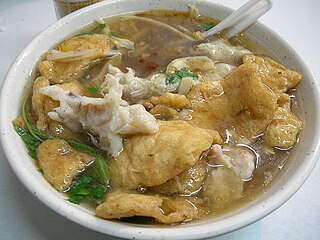
Chaoshan cuisine, also known as Chiuchow cuisine, Chaozhou cuisine or Teo-swa cuisine, originated from the Chaoshan region in the eastern part of China's Guangdong Province, which includes the cities of Chaozhou, Shantou and Jieyang. Chaoshan cuisine bears more similarities to that of Fujian cuisine, particularly Southern Min cuisine, due to the similarity of Chaoshan's and Fujian's culture, language, and their geographic proximity to each other. However, Chaoshan cuisine is also influenced by Cantonese cuisine in its style and technique.
Chen Kenichi, whose name is often romanized Chin Kenichi in Japanese sources, is a chef best known for his role as the Iron Chef Chinese on the television series Iron Chef (料理の鉄人). Nicknamed The Szechuan Sage, he wears a yellow outfit and rises into Kitchen Stadium holding a large Chinese chef's knife in his hand. He is the only Iron Chef to have held his position throughout the life of the show. He was born in Japan to a Japanese mother and a Chinese father of Japanese nationality, Chen Kenmin and his formal name is Ken'ichi Azuma.

Joël Robuchon was a French chef and restaurateur. He was named "Chef of the Century" by the guide Gault Millau in 1989, and awarded the Meilleur Ouvrier de France in cuisine in 1976. He published several cookbooks, two of which have been translated into English, chaired the committee for the Larousse Gastronomique, and hosted culinary television shows in France. He operated more than a dozen restaurants across Bangkok, Bordeaux, Hong Kong, Las Vegas, London, Macau, Monaco, Montreal, Paris, Shanghai, Singapore, Taipei, Tokyo, and New York City. His restaurants have been acclaimed, and in 2016 he held 32 Michelin Guide stars among them, the most any restaurateur has ever held.

Hokkien mee, literally "Fujian noodles", is a series of related Southeast Asian dishes that have their origins in the cuisine of China's Fujian (Hokkien) province.

Bak kut teh is a pork rib dish cooked in broth popularly served in Malaysia and Singapore where there is a predominant Hoklo and Teochew community.

Putian or Putien, also known as Puyang (莆阳) and Puxian (莆仙), historically known as Xinghua or Hing Hwa, is a prefecture-level city in eastern Fujian province, China. It borders Fuzhou City to the north, Quanzhou City to the south, and the Taiwan Strait's Xinghai Bay to the east. The Mulan River flows through the southern part of the city.

Fujian cuisine or Fujianese cuisine, also known as the Min cuisine or Hokkien cuisine, is one of the native Chinese cuisines derived from the native cooking style of China's Fujian Province, most notably from the provincial capital, Fuzhou. Fujian cuisine is known to be light but flavourful, soft, and tender, with particular emphasis on umami taste, known in Chinese cooking as xianwei, as well as retaining the original flavour of the main ingredients instead of masking them.

Singaporean cuisine derived from several ethnic groups which have developed through centuries of political, economic, and social changes of this cosmopolitan city-state.

Rice vermicelli is a thin form of noodle. It is sometimes referred to as 'rice noodles' or 'rice sticks', but should not be confused with cellophane noodles, a different Asian type of vermicelli made from mung bean starch or rice starch rather than rice grains themselves.

Lor mee is a Hokkien noodle dish from Zhangzhou served in a thick starchy gravy. Variants of the dish are also eaten by Hokkiens in Singapore, Indonesia and Malaysia. In the Philippines, the local variant is called Lomi or Pancit Lomi. The thick gravy is made of corn starch, spices, meat, seafoods and eggs. The ingredients added into the noodles are usually ngo hiang, fish cake, fish, round and flat meat dumplings, half a boiled egg, and other items depending on the stall and the price paid. Vinegar and garlic can be added as an optional item. Lor Mee can be served together with red chili. Traditional versions also include bits of fried fish as topping though few stalls serve this version anymore.
The Putian people or Xinghua people, are people from Putian, east Fujian, China. They are also known as Xinghua or Henghua people after the historical name of the area. They speak Min Chinese called Puxian Min.

Sinonovacula constricta, the constricted tagelus, Chinese razor clam or Agemaki clam, is a commercially important species of bivalve native to the estuaries and mudflats of China and Japan. It is extensively aquafarmed in China and other countries, with 742,084 tons worth US$667,876,000 harvested in 2008.
A global cuisine is a cuisine that is practiced around the world. A cuisine is a characteristic style of cooking practices and traditions, often associated with a specific region, country or culture. To become a global cuisine, a local, regional or national cuisine must spread around the world, its food served worldwide. There have been significant improvements and advances during the last century in food preservation, storage, shipping and production, and today many countries, cities and regions have access to their traditional cuisines and many other global cuisines.
Fong Chi Chung is the founder, owner and current chief executive officer of Putien Holdings Singapore, the parent company behind the successful and popular Putien restaurant branches, which serves authentic Heng Hwa cuisine.

Alvin Leung King-lon, is an English-born Hong Kong-Canadian chef and television personality. He holds two Michelin stars at his restaurant Bo Innovation and one Michelin star at Bo London. Nicknamed The Demon Chef, he invented his own cuisine named X-Treme Chinese, which includes meals such as an edible condom on a mushroom beach.

Hot pot or hotpot, also known as soup-food or steamboat, is a cooking method that originated in China. A heat source on the dining table keeps a pot of soup stock simmering, and a variety of Chinese foodstuffs and ingredients are served beside the pot for the diners to put into the hot stock.

Lychee pork or lizhi rou is one of the most well known dishes in Fujianese cuisine. Small pieces of deep-fried pork and sliced water chestnuts are served in a sweet and sour sauce. As is typical in Fujian, red yeast rice is used to add flavor and give a bright red color. The taste mixes sweet and sour, which is common in southern Chinese cuisine; the sauce is commonly made with ketchup, soy sauce and rice vinegar. Additional vegetable ingredients include yams, tomatoes, and green onions.

Haipai cuisine is a Western-style cooking that is unique to Shanghai, China. It absorbs the traditions of several cuisines from other regions of China and of Western cooking, adapting them to suit the local taste according to the features of local ingredients. It is divided into several major types: French, Italian, Russian, British, and German, among which the Russian-type dishes, such as the Shanghai-style borscht, receive a great welcome as they are more affordable. Today, the most famous dishes of Haipai cuisine are luó sòng tāng, fried pork chops, and Shanghai salad. Apart from the above-mentioned common dishes, baked clams, baked crabs, and jin bi duo soup are also popular among the Haipai dishes.
















